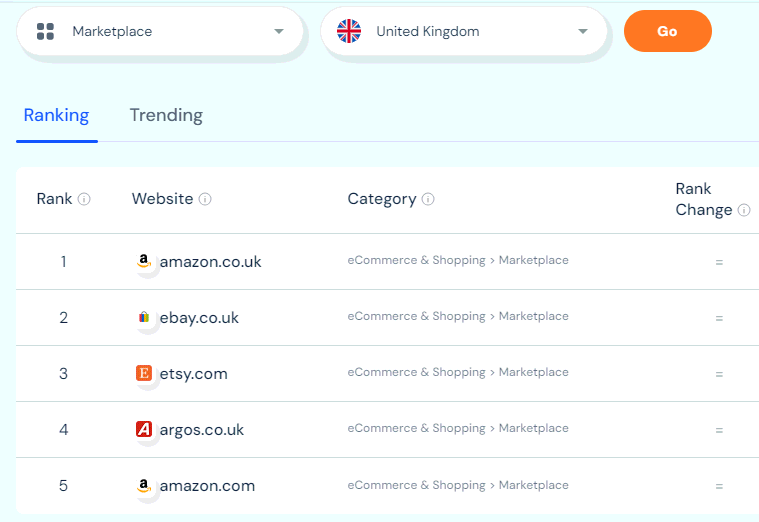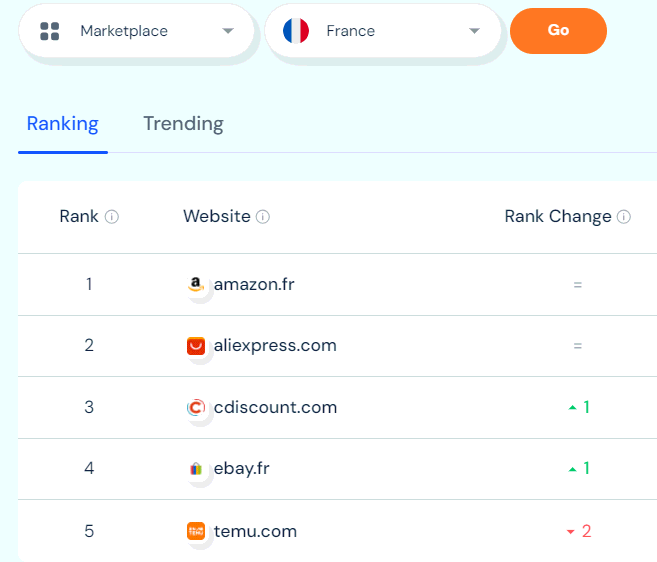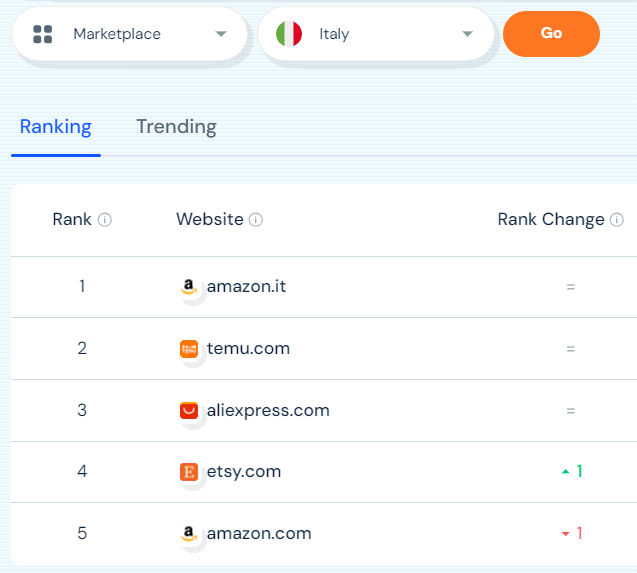Europe, which consists of 37 countries, is the third biggest eCommerce market. In 2022 it demonstrated the revenue level of $631.9 billion. With the annual growth rate of 9.3% this region's ecommerce sector will demonstrate the revenue level of $902.3 billion by 2027.
Ecommerce in Europe by countries
The ecommerce sector in Europe brings only up to 15% of total retail sales. However, it already is a huge industry from the financial standpoint. The ecommerce sector has now become a significant portion of european countries' GDP. In the United Kingdom, which is the most ecommerce-friendly region on the continent, online sales stand up for over 10% of country's GDP.
The United Kingdom, France, Germany, Spain, and Italy are the top five countries driving the european ecommerce market.

The United Kingdom emerges as a frontrunner in this digital shopping spree, boasting a substantial 10.26% share of GDP attributed to e-commerce, with a staggering revenue of 254 billion euros. This dominance underscores the UK's position as a major hub for online retail and digital transactions.
Denmark follows closely behind, with e-commerce contributing 7.83% to its GDP, generating revenue totaling 22.8 billion euros. Despite its smaller size compared to some of its European counterparts, Denmark's embrace of e-commerce technologies is evident in its robust digital economy.
Greece and Spain also showcase notable figures, with e-commerce contributing 7.09% and 6.64% to their respective GDPs. Despite economic challenges in recent years, both countries have leveraged e-commerce to drive growth, with revenues of 14.4 billion euros for Greece and 82.11 billion euros for Spain.
Moving eastward, Czechia and Poland highlight the increasing significance of e-commerce in Central Europe. Czechia records a 6.4% share of GDP and revenue of 12.48 billion euros, while Poland boasts a 5.37% share and 24.76 billion euros in revenue, reflecting the region's growing digital commerce landscape.
France, with a 5.19% share of GDP and revenue of 123.4 billion euros, stands as a powerhouse in the European e-commerce market. Its robust infrastructure and consumer base contribute significantly to the country's digital economy.
Meanwhile, Portugal and Romania exhibit promising potentials, with e-commerce revenues of €8.51 billion and €6.88 billion, respectively.
Germany, despite a relatively lower share of GDP at 3.24%, commands a formidable e-commerce revenue of €100.00 billion, indicating a robust digital market.
Italy closes the top-5 countries by the ecommerce revenue in Europe with 38.6 billion euros. This figure constitutes for the 2.35% of country's GDP.
Other nations like Norway and Hungary, though with smaller shares of GDP, contribute significantly to the e-commerce ecosystem, with respective revenues of €10.78 billion and €2.32 billion.

Three major facts on European ecommerce
What is the major product category in European ecommerce?
The quick answer: fashion is the major category. An analysis of the top 500 brands ranked by their cumulative online earnings across Europe for the year 2021 shows that Fashion items accounted for more than a quarter of the total sales.
Subsequent to Fashion, products falling under the categories of Electronics & Media and Toys, Hobby & DIY collectively made up 24% and 21% of the overall sales respectively, with Furniture & Appliance and Food & Personal Care products trailing behind.

What is the distrubution among brands in online sales in Europe?
In contrast to various other global markets, the eCommerce landscape across Europe exhibits lower levels of concentration. Europe, characterized by its diverse national markets rather than a unified ecommerce entity, sees only a handful of brands securing top positions across these markets. Despite this, the combined online net sales of the top five brands in Europe accounted for 28% of the total sales among the top 500 brands.

What is the largest brand in Europe in online sales?

List of top marketplaces in Europe
What are the top-5 marketplaces in Europe?
The online marketplace giant Amazon emerged as the undeniable leader in Europe's digital shopping realm, boasting a remarkable 1.3 billion monthly visits in 2023. eBay trailed behind in second place with a substantial 474 million visits, while Allegro secured the third spot, drawing close to 199 million visits.

Quick tour on european top marketplaces
Amazon
Amazon, established in 1994 by Jeff Bezos, ranks among the top-5 wealthiest individuals globally. Initially focusing on book sales, the company has broadened its scope to encompass electronics, clothing, and groceries, solidifying its status as a leading e-commerce platform worldwide. Moreover, Amazon has diversified into cloud computing, artificial intelligence, and digital streaming services like Prime Video, alongside hardware offerings such as Kindle e-readers and Echo smart speakers.
In Europe, Amazon's online presence lacks a unified website. The domain amazon.eu, owned by the company, merely directs visitors to an informational page, lacking a marketplace function.
Individual marketplace domains serve European countries. For example, the United Kingdom employs amazon.co.uk, Germany uses amazon.de, and Belgium utilizes amazon.com.be, among others.
eBay
Pierre Omidyar founded eBay in 1995, creating a platform where people and companies worldwide can trade various goods and services. On eBay, users can sell items through auctions or fixed-price listings, and the platform manages transactions and provides tools for communication and payment processing.
Initially focusing on consumer-to-consumer (C2C) sales, eBay has broadened its scope to include business-to-consumer (B2C) and business-to-business (B2B) transactions.
eBay offers diverse product categories, including electronics, fashion, collectibles, and more. Additionally, eBay owns other popular platforms like StubHub for ticket sales and Classifieds for local advertisements.
Allegro
Established in 1999, Allegro is an internet marketplace situated in Poland. Originally operating as an online auction site akin to eBay, it has developed into a complete e-commerce platform that includes fixed-price sales, auctions, and advertisements.
Allegro offers an extensive selection of items spanning various categories, including electronics, fashion, home goods, and beyond. Its reputation is built on its easy-to-use interface, safe payment processing, and dependable delivery options.
Zalando
Specializing in fashion and lifestyle goods, Zalando emerged in Germany in 2008. Since then, it has expanded into one of Europe's largest online retail platforms, presenting an extensive array of clothing, shoes, accessories, and beauty items for all ages and genders.
With its primary focus on Western and Central European markets like Germany, France, Italy, and the Netherlands, Zalando also extends its services to customers across various other regions through its online platform.
Zalando distinguishes itself with its broad assortment of brands, user-friendly shopping interface, adaptable delivery choices, and customer-focused amenities like hassle-free returns and tailored recommendations. Furthermore, the company remains committed to sustainability efforts and technological advancements, striving to improve its offerings while lessening its environmental footprint.
Vinted
Vinted centers around the exchange of pre-owned clothing, shoes, accessories, and fashion goods. Established in Lithuania in 2008, Vinted has expanded to become a major global platform, particularly in Europe, while also reaching into new territories.
On Vinted, users can showcase items they want to sell, set their own prices, and interact with potential purchasers. The platform highlights sustainability by encouraging the reuse and repurposing of fashion items, contributing to waste reduction.
Other marketplaces that are well known in Europe
Etsy
Etsy, an online marketplace, stands out for its focus on handmade and vintage items as well as craft supplies. It enables individual sellers to showcase and sell their unique products directly to customers. This platform is particularly favored by those seeking special, non-mass-produced items such as jewelry, art, clothing, and home decor.
Rakuten
Rakuten, a Japanese e-commerce giant, functions as a B2B2C marketplace, facilitating transactions between businesses and consumers while also supporting business-to-business dealings. Renowned for its diverse product selection spanning electronics, fashion, and household essentials, Rakuten frequently incentivizes customers with cashback or points for their purchases.
Wayfair
Wayfair, an American online retailer, specializes in furniture and household items. It boasts a wide array of products, including furniture, decorations, kitchenware, and outdoor gear. Wayfair is recognized for its broad product range, affordable prices, and emphasis on home decor and renovation essentials.
Wish
Based in the United States, Wish operates as an online marketplace that facilitates transactions between sellers and buyers. Notably, Wish is synonymous with its pocket-friendly prices, frequently supplied by merchants from China. The platform showcases a broad spectrum of products, encompassing electronics, fashion items, and home necessities, with a keen emphasis on providing value deals and discounts.
Aliexpress
AliExpress, a subsidiary of the Alibaba Group, operates as a prominent online retail platform originating from China. Renowned for its diverse product offerings, AliExpress showcases an extensive array of items such as electronics, fashion accessories, toys, and home appliances, all available at competitive price points. One of its key attractions lies in its direct-to-consumer approach, enabling buyers from around the globe to procure goods directly from manufacturers and wholesalers situated in China.
Cdiscount
Hailing from France, Cdiscount emerges as a prominent e-commerce destination, boasting an extensive assortment of merchandise spanning electronics, household appliances, furniture, and personal items. Renowned for its competitive pricing strategies and regular promotional campaigns, Cdiscount garners favor among thrifty shoppers not only in France but also across Europe.
Popularity of online marketplaces by country
The United Kingdom

The list of most popular marketplaces in the United Knigdom places the Amazon as the number one. The most interesting part is that Amazon is also the last one in the top-5 of most popular marketplaces. That is because people from the United Kingdom visit both local amazon.co.uk and global amazon.com.
- amazon.co.uk - 318 million monthly visitors with 86.07% of them from the United Kingdom and 3.39% form Ireland
- ebay.co.uk - 212.5 million monthly visitors with the United Kingdom's share of 87.38% visitors
- etsy.com - 429.8 million visitors per month globally with 9.08% of them from the United Kingdom
- argos.co.uk - 35.8 million visitors almost exclusively from the United Kingdom (97.13%)
- amazon.com - 21 million monthly visitors from the United Kingdom, which is 1.03% of total visitors
France

The latest ranking of online marketplaces in France by visitor traffic reveals some notable trends. Amazon France maintains the top spot, with no change in its rank, showcasing its continued popularity among consumers. Similarly, AliExpress remains steady in second place.
However, there are significant shifts in the lower positions of the top-5 rank, with Cdiscount climbing up one spot and eBay France also rising by one position. Temu makes a notable drop of two ranks.
- amazon.fr - 152 million monthly visitors with 88.59% of them from France
- aliexpress.com - 30.1 million monthly visitors from France
- cdiscount.com - 26.3 million visitors with 91.23% of them from France
- ebay.fr - 23.1 million visitors out of 26.5 total monthly visitors are from France
- temu.com - 20.59 million monthly visitors from France
Germany

Amazon Germany maintains its leading position in the country. Similarly, eBay Germany holds steady in second place, indicating its enduring appeal to German shoppers. Otto.de also retains its position at third place, reflecting its established presence in the market. Temu.com and Etsy.com finish the top-5 ranking with fourth and fifth positions respectively.
- amazon.de - 310 million monthly visitors from Germany
- ebay.de - 132.8 million monthly visitors from Germany
- otto.de - out of 44.2 million monthly visitors 95.64% of them are from Germany
- temu.com - 29 million German visitors per month
- etsy.com - 20.2 million monthly visitors from Germany
Spain

The spanish top-5 marketplaces rating includes Amazon at the first and fourth positions. Second and third positions are occupied by alixpress.com and elcorteingles.es respectively. The temu.com holds the last fifth place.
- amazon.es - 98.9 million monthly visitors from Spain
- aliexpress.com - 31.3 million monthly visitors from Spain
- elcorteingles.es - 26.9 million visitors with 94.1% of them from Spain
- amazon.com - Spain-originated visitors are less than one percent of 2100 million global visitors
- temu.com - only a small fraction of its monthly visitors come from Spain
Italy

People in Italy amazon.it, temu.com, aliexpress.com, etsy.com, and amazon.com as their top-5 paces for online shopping.
- amazon.it - out of 151.6 million its monthly visitors near 94.5% originate from Italy
- temu.com - 14 million visitors from Italy
- aliexpress.com - 10.8 million monthly visitors from Italy
- etsy.com - 5.7 million visitors from Italy
- amazon.com - Italy for this domain is counted in "Others" section
Summarizing top marketplaces in Europe
Europe's e-commerce landscape is diverse and dynamic, characterized by robust growth and significant contributions to the GDP of its member countries.
The United Kingdom leads the pack, with e-commerce accounting for over 10% of its GDP, while other countries like Denmark, Greece, and Spain also show impressive integration of digital commerce into their economies. The region's e-commerce market, projected to reach $902.3 billion by 2027, is driven by a variety of product categories and marketplaces, with fashion emerging as the top category. Despite the dominance of Amazon and eBay, the market remains less concentrated than in other regions, allowing for a more varied and competitive online retail environment.
This vibrant e-commerce ecosystem not only boosts the European economy but also offers consumers a wealth of choices, making it a key player in the global digital commerce arena.




